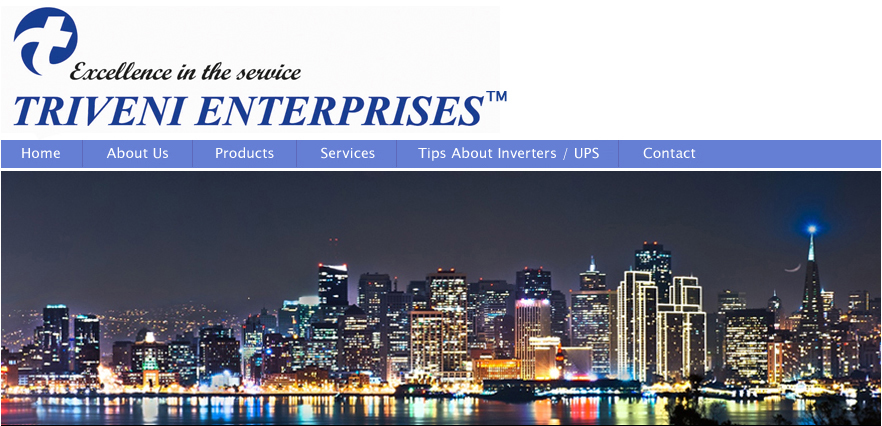SALES & SERVICE OF UPS / INVERTER / LIFT INVERTER / BATTERIES
|
| Tips About Inverters / UPS... |
|
 |
What is Inverter? |
|
Inverter is basically used for Lighting Load as Inverter takes DC power and then converts into AC power i.e. from Battery to Electricity and helps in running electronic equipment and appliances during Electricity power cutout. The changeover time of the Inverter from Electricity fail to Inverter mode is more than 500 milliseconds.
|
|
|
 |
What can be connected on Inverter? |
|
Inverters can be connected to the Lighting Load like Tubelights, Fans, CFL and TV. It is not suitable to run Computer loads such as Printers, Electronic devices. |
|
|
 |
What is UPS? |
|
UPS is Un-Interrupted Power supply which is similar to Inverter in concept. The only difference is that the Input voltage is monitored and controlled to some extent (using filter circuit and automatic voltage regulator) due to which during power cutout, the appliances running on UPS do not switch off and on. The changeover time is fast between 0 to 15 milliseconds hence the Computer Loads and Machineries used in Hospitals are been connected to the UPS and not Inverters.
|
|
|
 |
What can be connected on UPS? |
|
UPS can be connected to the Computer systems, Printers and any other Electronic devices which re-boots during power cutouts. |
|
|
 |
What is the Difference between Inverter and UPS? |
|
The difference between Inverter and UPS is Inverter takes long time between changeovers from Electricity to Battery Power which is more than 500 milliseconds however the UPS is very fast is changing over between 0 to 15 millisecond. |
|
|
 |
What is the meaning of VA / KVA? |
|
The output of a UPS or Inverter is measured in Volt-Amperes or VA {which is actually “Output Voltage x Output Current”}. KVA means Kilo-Volt-Amperes {which is VA x 1000} |
|
|
 |
What should one consider when purchasing a UPS/ Inverter System ? |
|
When purchasing a UPS / Inverter System consider following points
 Always select a UPS / Inverter of at least 25 % Extra capacity for future load expansion purpose. Always select a UPS / Inverter of at least 25 % Extra capacity for future load expansion purpose.
 Select appropriate Battery capacity suitable to the backup time requirement. Select appropriate Battery capacity suitable to the backup time requirement.
 Connect only the required points to the UPS / Inverter via proper wiring work which get done from qualified Electrician. Connect only the required points to the UPS / Inverter via proper wiring work which get done from qualified Electrician.
 See the Reliability of the Vendor from whom purchasing the Product who has proper Customer Service Support System. See the Reliability of the Vendor from whom purchasing the Product who has proper Customer Service Support System.
 Don’t forget to compare the Price, Warranty and Quality of the Product. Don’t forget to compare the Price, Warranty and Quality of the Product. |
|
|
 |
Can the Inverter / UPS be overloaded above its Rated Capacity? |
|
We never advice the overload of any points / gadgets to be used on the Inverter / UPS, as it may damage the gadgets used or the Inverter / UPS. |
|
|
 |
Which is the suitable place to keep Inverter / UPS from my Batteries? |
|
It is always recommended to keep short distance as possible between Cables and Inverter / UPS. This will ensure the Batteries to give good performance without any losses. We suggest that not more than three feet Cables should be connected to the Inverter from the Battery to ensure the good performance. |
|
|
 |
Can Mixer, Refrigerator, Hair-Drier or Water Pump can be used on Inverter / UPS System? |
|
It is not advisable to use the above Appliances on the Inverter / UPS System, since the surge current is very high and these Inverters / UPS are not designed to handle such high surge current. |
|
|
 |
What do you mean by Bypass of Inverter / UPS and how it works? |
|
Bypass is a Two-Way Switch which is given near the Inverter and connected between the input and output of the Inverter System. This Bypass Switch allows power to continue to flow to connected equipment if the Inverter / UPS System encounter an internal error or overload condition. The bypass function uses the A/C supply power as its standby source of power and automatically by-pass quickly power to ensure that the connected equipment continues to operate without effecting its normal operation.
|
 |
How to do battery maintenance/care checklist? |
|
General Performance / Longevity: • Do not discharge a battery beyond 80% of rated capacity. (1.140 -1.160 SPG) • Do not use batteries with specific gravity below 1120 • Only charge batteries on properly matched chargers (voltage, A.H. and type. Max overall AH variance of 10%) • Always allow your battery to cool down after charging (Ideal usage: 80% discharge, 6-8 hours charge time, 4 hours cool down time). • Contact your Battery Service Representative (BSR) for an inspection if batteries on-charge exceed 115 deg. F. • Report any problems (even minor) to your BSR.
|
|
|
|
 |
|
| TRIVENI ENTERPRISES |
| Address |
: |
42/713 KOKAN VASAT, BEHIND DOMINOS PIZZA,NEAR SAMPADA HOSPITAL, CHICKENGHAR ,
KALYAN [W]
KALYAN, MAHARASHTRA 421301India
|
| Mobile No. |
: |
+ 91 9820502189 / 9702065944 |
|
|
|
